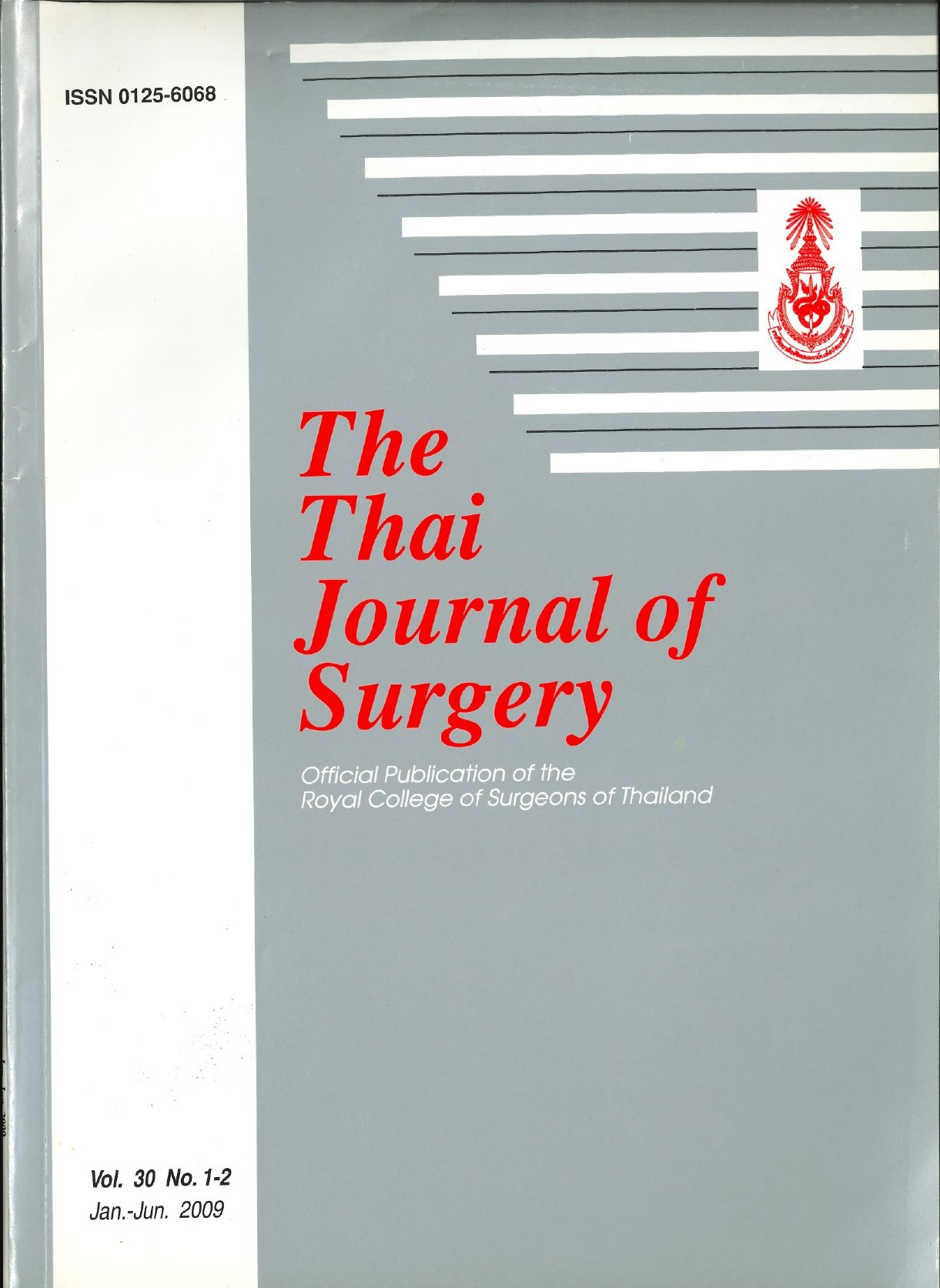A 9-year Experience of Laparoscopic Herniorrhaphy at Fort Prajaksilapakom Hospital
Keywords:
extraperitoneal repair, inguinal hernia, laparoscopic herniorrhaphyAbstract
Objective: This study was to review the overall outcome of the laparoscopic totally extraperitoneal(TEP) repair for inguinal hernia during the past 9 years.
Methods: This retrospective study was undertaken in 107 patients with 119 hernial defects. A single
surgeon had used TEP approach from March 2000 - October 2008. The medical records were reviewed in the
following data categories: gender, age, weight, duration of symptom, diagnosis, underlying condition, previous
surgery, operation time, number of staples, drain applying, complication, and follow up time.
Results: The average age of 107 patients was 60.1 years old. There were 98 unilaterals and 9 bilaterals.
The indirect hernia was in 93 patients (78.1%) and direct hernia was in 26 patients (21.9%). Of 119 hernia
repairs there were 3 patients converted to open herniorrhaphy (2.8%) and one of these three had small bowel
injury (0.9%). The recurrence was occurred in 1 patient (0.9%). The mean operation time was 72.74 minutes
(40-160), LOS 2.85 days (1-8). The complication rate was 18.9% (20 patients), most of them were minor
conditions such as small hematoma (10), seroma (2), and subcutaneous emphysema (1). There was no mortality
with an average 38.8 months follow up (1-106 months).
Conclusion: The TEP approach was successful, highly safe and efficient due to significant low recurrent
rate and no mortality while comparing to either other laparoscopic hernioplasty or open tension free repair.
However, the outcomes were dependent on how to select patients, the expertise of surgeon, and surgical
technique modification.
References
of surgery. In: Charles B, editor. Principle of surgery. 8th ed.
New York: McGraw Hill; 2005. p. 1353-94.
2. Hawn MT, Itani KM, Giobbie-Hurder A, McCarthy M Jr,
Jonasson O, Meumayer LA. Patient-reported outcomes
after inguinal herniorrhaphy. Surgery 2006;140:198-205.
3. Vidovic D, Kirac I, Glavan E, Filipovic-Cugura J, Ledinsky M,
Bekavac-Beslin M. Laparoscopic totally extraperitoneal
hernia repair versus open Lichtenstein hernia repair: results
and complications. J Laparoscendosc Adv Surg Tech A
2007;17:585-90.
4. Eklund A, Rudberg C, Smedberg S, Enander LK, Leijonmarck
CE, Osterberg J, et al. Short-term results of a randomized
clinical trial comparing Lichtenstein open repair with totally
extraperitoneal laparoscopic inguinal hernia repair. Br J
Surg 2006;93:1060-8.
5. Ramshaw BJ, Tucker JG, Conner T, Mason EM, Duncan TD,
Lucas GW. A comparison of the approaches to laparoscopic
herniorrhphy. Surg Endosc 1996;10:29-32.
6. Haidenberg J, Kendrick ML, Meile T, Farley DR. Totally
extraperitoneal (TEP) approach for inguinal hernia: the
favorable learning curve for trainees. Curr Surg 2003;60:65-
8.
7. Edwards CC 2nd, Bailey RW. Laparoscopic hernia repair:
the learning curve. Surg Laparosc Endosc Percutan Tech
2000;10:149-53.
8. Dagash H, Chowdhury M, Pierro A. When can I be proficient
in laparoscopic surgery? A systemic review of the evidence.
J Pediatr Surg 2003;38:720-4.
9. Ferzli G, Sayad P, Huie F, Hallak A, Usal H. Endoscopic
extraperitoneal herniorrhaphy. A 5-year experience. Surg
Endosc 1998;12:1311-3.
10. Heithold DL, Ramshaw BJ, Mason EM, Duncan TD, White J,
Dozier AF, et al. 500 total extraperitoneal approach
laparoscopic herniorrhaphies: a single institute review. Am
Surg 1997;63:299-301.
11. Khoury N. A comparative study of laparoscopic
extraperitoneal and transabdominal preperitoneal
herniorrhaphy. J Laparosc Surg 1995;5:349-55.
12. Tucker JG, Wilson RA, Ramshaw BJ, Mason EM, Duncan TD,
Lucas GW. Laparoscopic herniorrhaphy: technical concerns
in prevention of complications and early recurrence. Am
Surg 1995;61:36-9.
13. Ferzli G, Kiel T. Evolving techniques in endoscopic
extraperitoneal herniorrhaphy. Surg Endosc 1995;9:928-30.
14. Sayad P, Abdo Z, Cacchione R, Ferzli G. Incidence of
incipient contralateral hernia during laparoscopic hernia
repair. Surg Endosc 2000;14:543-5.
15. Lowham AS, Filipi CJ, Fitzgibbons RJ Jr, Stoppa R, Wantz GE,
Felix EL, et al. Mechanisms of hernia recurrence after
preperitoneal mesh repair. Traditional and laparoscopic.
Ann Surg 1997;225:422-31.
16. Sayad P, Hallak A, Ferzli G. Laparoscopic herniorrhaphy:
review of complications and recurrence. J Laparosc Adv
Surg Tech A 1998;8:3-10.
17. Freund HR, Seror D, Eimerl D, Zamir O. Preliminary experience
with laparoscopic repair of inguinal hernias. Harefuah
1997;133:524-7, 591.
18. Poobalan AS, Bruce J, Smith WC, King PM, Krukowski ZH,
Chamvers WA. A review of chronic pain after inguinal
herniorrhaphy. Clin J Pain 2003;19:48-54.
19. Keller JE, Stefanidis D, Dolce CJ, Iannitti DA, Kercher KW,
Heniford BT. Combined open and laparoscopic approach
to chronic pain after inguinal hernia repair. Am Surg
2008;74:695-700.
20. Korman JE, Hiatt JR, Feldmar D, Phillips EH. Mesh
configurations in laparoscopic extraperitoneal hernirrrhaphy.
A comparison of techniques. Surg Endosc 1997;11:1102-5.
Downloads
Published
How to Cite
Issue
Section
License
Articles must be contributed solely to The Thai Journal of Surgery and when published become the property of the Royal College of Surgeons of Thailand. The Royal College of Surgeons of Thailand reserves copyright on all published materials and such materials may not be reproduced in any form without the written permission.



